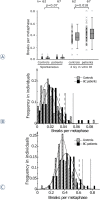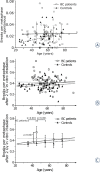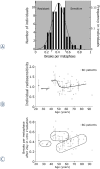Individual radiosensitivity in a breast cancer collective is changed with the patients' age
- PMID: 24587784
- PMCID: PMC3908852
- DOI: 10.2478/raon-2013-0061
Individual radiosensitivity in a breast cancer collective is changed with the patients' age
Abstract
Background: Individual radiosensitivity has a crucial impact on radiotherapy related side effects. Our aim was to study a breast cancer collective for its variation of individual radiosensitivity depending on the patients' age.
Materials and methods: Peripheral blood samples were obtained from 129 individuals. Individual radiosensitivity in 67 breast cancer patients and 62 healthy individuals was estimated by 3-color fluorescence in situ hybridization.
Results: Breast cancer patients were distinctly more radiosensitive compared to healthy controls. A subgroup of 9 rather radiosensitive and 9 rather radio-resistant patients was identified. A subgroup of patients aged between 40 and 50 was distinctly more radiosensitive than younger or older patients.
Conclusions: In the breast cancer collective a distinct resistant and sensitive subgroup is identified, which could be subject for treatment adjustment. Preliminary results indicate that especially in the range of age 40 to 50 patients with an increased radiosensitivity are more frequent and may have an increased risk to suffer from therapy related side effects.
Keywords: age; breast cancer; chromosomal aberrations; fluorescence in situ hybridization; individual radiosensitivity; radiotherapy.
Figures




References
-
- Dikomey E, Borgmann K, Peacock J, Jung H. Why recent studies relating normal tissue response to individual radiosensitivity might have failed and how new studies should be performed. Int J Radiat Oncol Biol Phys. 2003;56:1194–200. - PubMed
-
- Zschenker O, Raabe A, Boeckelmann IK, Borstelmann S, Szymczak S, Wellek S, et al. Association of single nucleotide polymorphisms in ATM, GSTP1, SOD2, TGFB1, XPD and XRCC1 with clinical and cellular radiosensitivity. Radiother Oncol. 2010;97:26–32. - PubMed
LinkOut - more resources
Full Text Sources
Other Literature Sources
